Many people who live in the western half of the United States experience hot, dry summers followed by cold winters. Often it can be hard to find plants that will thrive in these temperature extremes. Toss in the fact that much of the region is affected by drought, and plant selection becomes even more complicated. However, before you resign yourself to a lackluster garden, check out these colorful drought-tolerant plants that can handle both hot and cold temperatures of the Wild West.
Not in the western U.S.? Browse plants native to more regions of the U.S.
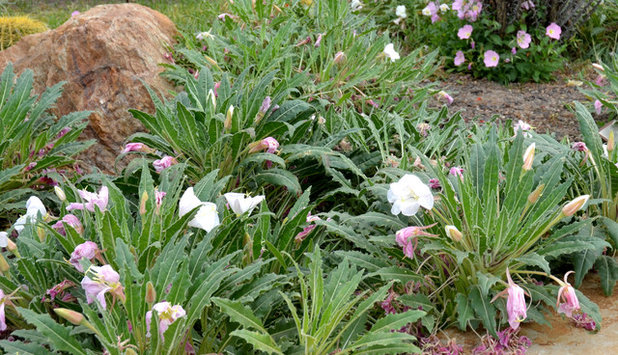
Noelle Johnson Landscape Consulting
1. Tufted Evening Primrose(
Oenothera caespitosa)
Native to the higher elevation regions (4,500 to 7,500 feet) of the western United States
In spring, the dark green foliage is covered in 3- to 4-inch-wide flowers, which can last through summer and early fall when provided supplemental water. The large white flowers burst forth toward the end of the day, fading to a delicate shade of pink the following day and adding a touch of drama to this hardy ground cover.
This plant is best appreciated where people can view it in the late afternoon or early evening and early morning hours, when flowers are at their peak. Placing it along pathways or near a front entry ensures that you can get up close to enjoy the flowers. Use it as an understory plant for cold-hardy blue-gray or greenish-gray succulents, such as candelilla (
Euphorbia antisyphilitica, USDA Zone 8; find your zone), whale’s tongue agave (
Agave ovatifolia, Zone 7) and common sotol (
Dasylirion wheeleri, Zone 6), or plant underneath the iconic ocotillo (
Fouquieria splendens, Zone 7).
Where it will grow: Hardy to minus 20 degrees Fahrenheit, or minus 29 degrees Celsius (USDA Zone 5; find your zone)
Water requirement: Water every 10 days spring through early fall and rely on rainfall in winter; in low-desert zones, water weekly spring through fall and monthly in winter.
Light requirement: Full sun (light shade in low-desert gardens)
Mature size: 1 foot tall and 2 to 3 feet wide
Planting notes: Plant in well-drained soil in full sun (or light shade in desert gardens). Fertilize with a slow-release or organic fertilizer in spring.
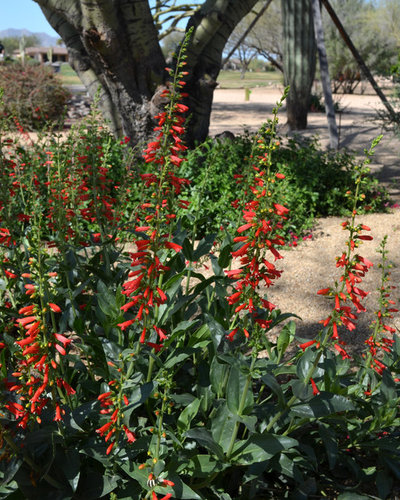
Noelle Johnson Landscape Consulting
2. Firecracker Penstemon(
Penstemon eatonii)
Native to the desert regions of California, Nevada, Arizona, New Mexico and Colorado
In spring, the deep green foliage of firecracker penstemon takes a back seat as 2-foot-tall spikes covered in 1-inch flowers burst forth, adding beauty to the landscape as well as providing a welcome treat for hummingbirds and bees. Flowering occurs primarily throughout the spring in most regions; in low-desert gardens, blooming begins in winter, and flowers begin to appear in high-elevation gardens in summer.
Plant alongside boulders or scatter throughout the landscape for a natural look. For maximum color impact, group three together. Prune away spent flowering stalks to stimulate another flush of blooms.
Where it will grow: Hardy to minus 20 degrees Fahrenheit, or minus 29 degrees Celsius (Zone 5)
Water requirement: Drought-tolerant once established, it should be watered weekly when in bloom. Thereafter, water every two weeks in summer and monthly in winter.
Light requirement: Full sun
Mature size: 1 foot tall and wide (2 feet tall when in flower)
Planting notes: Plant in well-drained soil in full sun.
See how to grow firecracker penstemon
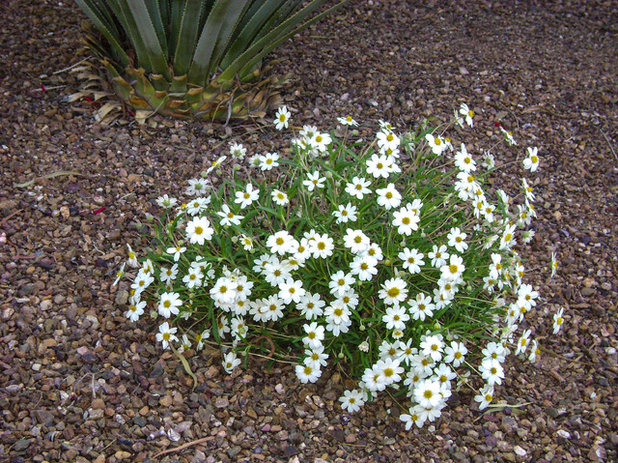
Noelle Johnson Landscape Consulting
3. Blackfoot Daisy(
Melampodium leucanthum)
Native from the Central Plains to the Southwest and into northern Mexico
Daisies brighten up any landscape, and this drought-tolerant ground cover is no exception. One-inch-wide daisies appear on blackfoot daisy, also called prairie blackfoot, in spring over dark green foliage. Although spring is when most daisies show up on this ground cover, flowering can also occur throughout summer and early fall.
Blackfoot daisy’s natural mounding habit makes it a great choice for tucking into crevices next to boulders or planting in groups of three for greater impact. Pair it with pink, red or yellow flowering perennials for great color contrast.
Where it will grow: Hardy to minus 20 degrees Fahrenheit, or minus 29 degrees Celsius (Zone 5)
Water requirement: Extremely drought-tolerant once established, it does best when watered two or three times a month during the summer and once a month in winter.
Light requirement: Full, reflected sun to filtered shade
Mature size: 1 foot tall and 1½ feet wide
Planting notes: Plant in well-drained soil in full sun to light shade.
See how to grow blackfoot daisy
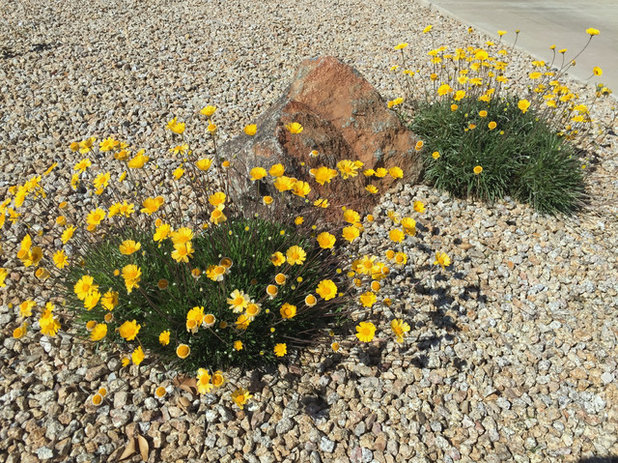
Noelle Johnson Landscape Consulting
4. Angelita Daisy(
Tetraneuris acaulis)
Native to the western and central United States; also found in Alberta and Saskatchewan, Canada, as well as northern Mexico
Don’t be deceived by angelita daisy’s small size. It’s tough, thriving in both the cold and extreme heat that characterizes many of the arid regions of the western half of the United States. Yellow daisies are borne aloft dark green grassy foliage. For zones 5 and 6, the bloom season is in summer. In warmer zones, the bloom season lasts longer, with flowers appearing spring through fall. For those who live in low-desert zones, the flowering never stops adding a welcome spot of color, no matter what time of year it is.
Due to their compact size, angelita daisies can get lost in the landscape when planted singly, so always plant them in groups of at least three. Place next to boulders along with a brightly colored penstemon, or plant in rows along a pathway or narrow raised bed. Use them to soften a landscape planted with cactuses and succulents.
Where it will grow: Hardy to minus 20 degrees Fahrenheit, or minus 29 degrees Celsius (Zone 5)
Water requirement: Water weekly in summer, every two weeks in spring and fall, and monthly in winter.
Light requirement: Full sun; reflected heat
Mature size: 12 inches tall and 15 inches wide
Planting notes: Plant in well-drained soil in full sun to light shade.
See how to grow angelita daisy
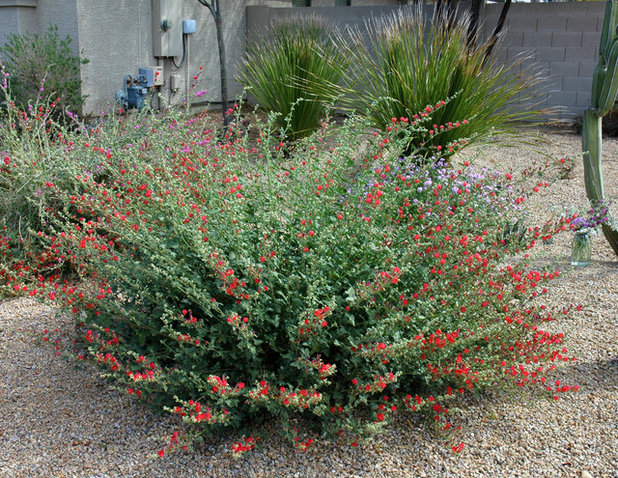
Noelle Johnson Landscape Consulting
5. Globe Mallow(
Sphaeralcea ambigua)
Native to the desert regions of southeastern California, Arizona, Nevada, Utah; also grows in Baja and Sonora, Mexico
At first glance, globe mallow’s small cup-shaped flowers look as if they belong in an English cottage garden, rather than in an arid landscape. Don’t let its flowers fool you; globe mallow thrives in seemingly inhospitable conditions.
Beginning in late winter — in spring for zones 6 to 8 — stems covered in 1-inch-wide flowers begin to appear. A smaller bloom cycle occurs in early fall. Although orange is the most common flower color, blooms ranging from white, pink, purple and even red exist. The only way to tell which color a particular globe mallow produces is to see it in bloom or purchase a specific variety, such as ‘Louis Hamilton’, which has red flowers.
Because of its natural, open growth habit, globe mallow looks best when interspersed with other perennials in an informal landscape or planted near cactuses and succulents, such as prickly pear. It can also be used to anchor a wildflower garden. Prune back to 1 foot tall after flowering to keep a neat appearance.
Where it will grow: Hardy to minus 10 degrees Fahrenheit, or minus 23 degrees Celsius (Zone 6)
Water requirement: Water every two weeks while in bloom and three weeks in summer.
Light requirement: Full sun
Mature size: 3 feet tall and wide
Planting notes: Plant in well-drained soil in full sun.
See how to grow globe mallow
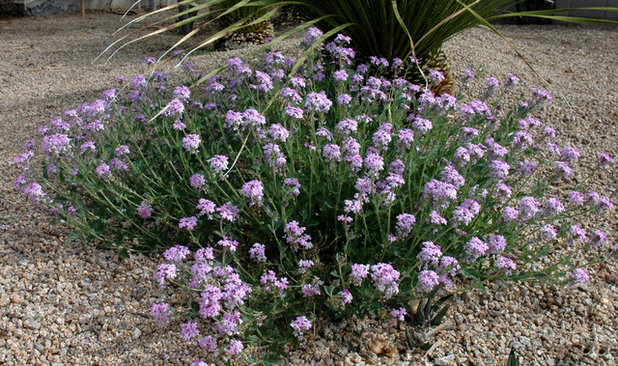
Noelle Johnson Landscape Consulting
6. Southwestern Mock Vervain(
Glandularia gooddingii)
Native to California, Nevada, Arizona, Utah, New Mexico, Texas and northern Mexico
Butterflies and birds welcome this Southwestern verbena species as it decorates landscapes with its fragrant lavender flowers. Like most plants native to the Southwest, Southwestern mock vervain thrives in full sun and needs only occasional shearing of spent flowers. Clusters of five small flowers begin to appear as soon as late winter — in warmer zones — and continue blooming into the summer months.
This verbena’s attractive mounding growth habit makes it an ideal choice for an understory plant that adds interest at the ground level. Plant it alongside your favorite agave species or by a columnar cactus. Southwestern mock vervain can also add beauty to a perennial bed filled with other drought-tolerant perennials, such as angelita daisy (
Tetraneuris acaulis, Zone 5), blackfoot daisy (
Melampodium leucanthum, Zone 5)
and Parry’s penstemon (
Penstemon parryi, Zone 5).
Where it will grow: Hardy to minus 10 degrees Fahrenheit, or minus 23 degrees Celsius (Zone 6)
Water requirement: Water every three weeks in summer and monthly in spring and fall. In low-desert gardens, water weekly in summer and every two weeks in spring and fall.
Light requirement: Full sun
Mature size: 1 foot tall and 2 to 3 feet wide
Planting notes: Plant in well-drained soil in full sun or light shade.
See how to grow Southwestern mock vervain
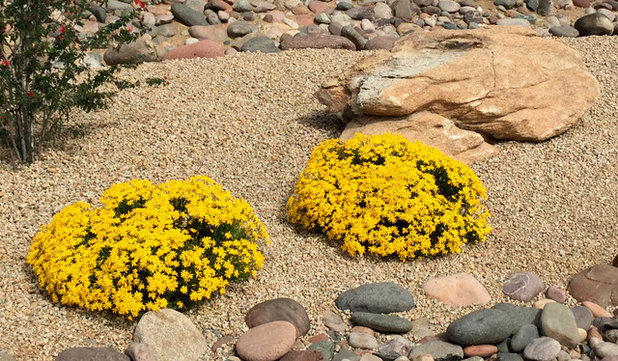
Noelle Johnson Landscape Consulting
7. Damianita(
Chrysactinia mexicana)
Native to New Mexico, Texas and northern Mexico
Damianita’s aromatic foliage is made up of dark green needlelike leaves. This Southwestern native has an attractive mounded growth habit, which is dramatically transformed by the appearance of deep yellow flowers. Although small, they almost completely cover the foliage and create a stunning impact from their sheer number. The heaviest bloom season begins in spring and reoccurs in fall. Sporadic flowering can also occur in summer.
For maximum color impact, plant in groups of three or more along pathways, near swimming pools or use to dress up a boulder. Damianita also looks great when planted in the garden foreground, with flowering shrubs in the background, or alongside drought-tolerant perennials. Lightly shear after flowering to promote additional bloom.
Where it will grow: Hardy to minus 10 degrees Fahrenheit, or minus 23 degrees Celsius (Zone 6)
Water requirement: Water every three weeks in summer and monthly in spring and fall. In low-desert gardens, water weekly in summer and every two weeks in spring and fall.
Light requirement: Full sun
Mature size: 1 foot tall and 2 feet wide
Planting notes: Plant in well-drained soil in full sun.
See how to grow damianita
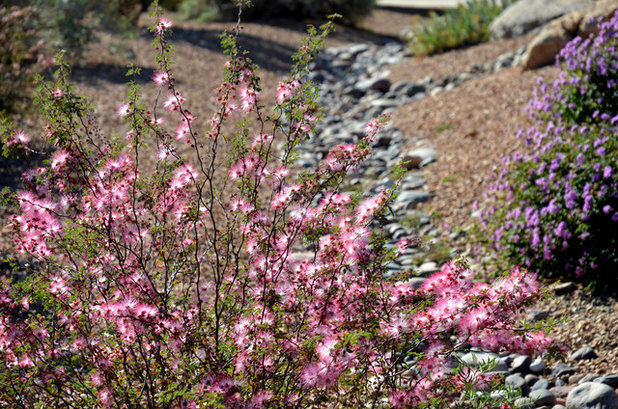
Noelle Johnson Landscape Consulting
8. Pink Fairy Duster(
Calliandra eriophylla)
Native to the deserts of southeastern California, southern Arizona, New Mexico and western areas of Texas; also grows in northern Mexico
Pink fairy duster’s foliage is made up of tiny leaflets, which create an airy green backdrop throughout the drought-tolerant landscape. This medium-size shrub transforms when fuzzy pink flowers shaped like small feather dusters appear. Flowers appear in late winter into spring and can reoccur in late summer or fall. The 1-inch-wide flowers attract hummingbirds, as well as other wildlife that eat the seeds.
Use in an informal, naturally themed garden by pairing it with cactus or other succulents, such as agave, where it can show its feathery foliage to maximum effect. Pink fairy duster can also be used to create an informal hedge, planted alongside large boulders or to help anchor a wildflower garden.
Where it will grow: Hardy to 10 degrees Fahrenheit, or minus 12 degrees Celsius (Zone 7)
Water requirement: It’s able to survive on natural rainfall once established, but its appearance and flowering are improved when watered deeply twice a month in summer and monthly in spring and fall.
Light requirement: Full sun but can tolerate light shade
Mature size: 2 to 3 feet tall and 2 to 4 feet wide
Planting notes: Plant in well-drained soil in full sun or light shade.
See how to grow pink fairy duster
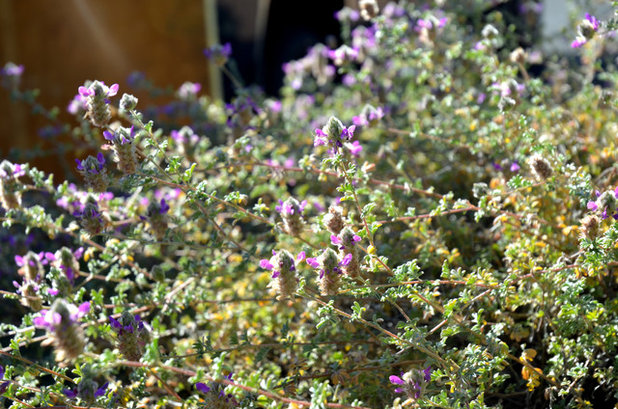
Noelle Johnson Landscape Consulting
9. Trailing Indigo Bush(
Dalea greggii)
Native to Texas; also found throughout much of Mexico
Passers-by often first notice the attractive lacy gray-green foliage of this ground cover and how it softens the landscape. That is, until they walk closer and see a welcome surprise with trailing indigo bush’s tiny purple flowers. Flowering of the half-inch-wide globular flowers begins in spring and lasts into summer. Occasional blooms may also appear in the fall. Trailing indigo bush, also called Gregg’s prairie clover, makes an excellent ground cover, as its stems root where they touch the ground. Flowers also attract bees.
The silvery-green ground cover can be used to soften the landscape visually while helping to reduce the reflected heat from landscape rock and sidewalks. Use it alongside your favorite succulents or boulders for great texture contrast.
Where it will grow: Hardy to 0 degrees Fahrenheit, or minus 18 degrees Celsius (Zone 7)
Water requirement: Water deeply every two weeks in summer, every three weeks in spring and fall, and monthly in winter.
Light requirement: Full sun; reflected heat
Mature size: 1 to 2 feet tall and 2 to 4 feet wide
Planting notes: Plant in well-drained soil in full sun.
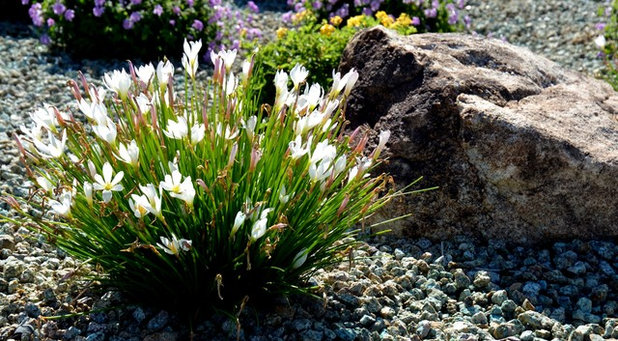
Noelle Johnson Landscape Consulting
10. Zephyrlily(
Zephyranthes candida)
Native to Texas, Mexico and Central America
The ephemeral white blossoms of zephyrlily, also called rainlily, and its bright green foliage are a rather unexpected treat for those who live in hot, dry climates. This is one tough plant that can easily handle the heat and cold. Planted from bulbs, zephyrlily produces white blossoms in late summer and fall, often in response to rain.
Z. candida’s foliage is evergreen, and it can be grown throughout most of the southern United States.
Create natural-looking drifts with at least three plants growing alongside colorful perennials, such as angelita daisy (
Tetraneuris acaulis, Zone 5) or autumn sage (
Salvia greggii,
Zone 7), for great color contrast. Zephyrlilies can also be planted next to spiky succulents, such as common sotol (
Dasylirion wheeleri, Zone 6), for a pairing of distinct textures.
Where it will grow: Hardy to 0 degrees Fahrenheit, or minus 18 degrees Celsius (Zone 7)
Water requirement: It’s moderately drought-tolerant once established; water weekly in summer and every three weeks in winter.
Light requirement: Full sun (partial shade in low-desert gardens)
Mature size: 6 to 12 inches tall and wide
Planting notes: Plant bulbs in fall in well-drained soil that has been amended with compost at a ratio of 1 part compost to 1 part native soil. Dig holes that are 4 inches apart and 2 inches deep, and add an all-purpose fertilizer at the bottom of each hole before planting.
See how to grow zephyrlilies





